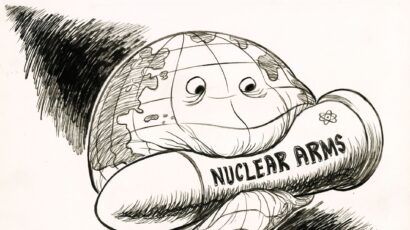Maximizing U.S. federal loan guarantees for new nuclear energy
By John C. Slocum, John J. Reed | July 29, 2009
In May, the Energy Department confirmed that it was selecting four applicants to proceed to the penultimate “due diligence” stage of the $18.5-billion federal loan-guarantee program for new nuclear power projects. While being careful to note that none of the 10 projects that submitted full applications have been eliminated, Energy is proceeding with further review of the applications submitted by NRG Energy’s South Texas 3 and 4 project near Houston; Unistar’s (a joint venture of Électricité de France and Constellation Energy) Calvert Cliffs 3 project southeast of Washington, D.C.; Georgia Power’s Vogtle 3 and 4 project near Augusta, Georgia; and Scana’s Virgil C. Summer 3 and 4 project near Columbia, South Carolina.
The loan-guarantee program, part of the 2005 Energy Policy Act, raises two main issues that have profound impacts upon the future of nuclear power in the United States. First, given the relatively small size of the congressional appropriation (cost estimates for new nuclear power plants are currently anywhere from $6 billion-$10 billion each) and regulations governing the loan-guarantee program’s implementation, how likely is it that the program will spur new U.S. nuclear power projects? Second, although the Energy Policy Act was intended to promote the early commercial deployment of advanced energy technologies and the reduction of greenhouse gas emissions, it also directed Energy to protect the interests of the U.S. taxpayer in case of loan defaults. Promoting new technologies, however, may not be compatible with minimizing financial risk. This raises the policy question of how best to use the public funds to support new nuclear energy initiatives.
Background on the program. Title XVII of the Energy Policy Act authorized the energy secretary, after consulting with the treasury secretary, to make loan guarantees for projects that “(1) avoid, reduce, or sequester air pollutants or anthropogenic emissions of greenhouse gases; and (2) employ new or significantly improved technologies as compared to commercial technologies in service in the United States at the time the guarantee is issued,” provided that “there is reasonable prospect of repayment of the principal and interest on the obligation by the borrower.” The act identified 10 technology categories that are eligible for loan guarantees, including advanced nuclear energy.
In October 2007, Energy adopted regulations governing implementation of the loan-guarantee program. Key provisions included clarification of what technologies qualify as “new or significantly improved”; identification of appropriate financing terms for eligible projects (e.g., debt as a percentage of total project cost); and definition of conditions that Energy intends to include in loan-guarantee agreements (e.g., collateral security rights). Energy also determined that it would solicit projects specifically deploying technologies for which Congress intended to use taxpayer funds.
Taken together, three of the four short-listed applicants represent the leading applications for specific nuclear technologies. Georgia Power’s Vogtle project and Scana’s Virgil C. Summer project both are based on Westinghouse’s AP1000 reactor. Unistar’s Calvert Cliffs project is the NRC’s primary application for Areva’s Evolutionary Power Reactor, as is NRG Energy’s South Texas project for Toshiba’s version of the Advanced Boiling Water Reactor. Two of the final four are being developed by Georgia Power and Scana, utilities in state-regulated markets, and two are being developed by so-called merchant operators, Unistar and NRG Energy, which do business in fully, or partially, deregulated markets.
Our research indicates that of the 15 other U.S. new nuclear projects that were publicly known or announced as of July 1, 2009, those that have not moved forward to the final stage of the loan guarantee application process include:
- Those that didn’t file Part I applications: Amarillo Power; Alternate Energy Holdings’ Elmore County project, DTE Energy’s Fermi project, Progress Energy’s Harris project, and Florida Power & Light’s Turkey Point project.
- Those that filed Part I applications, but didn’t file Part II applications: Entergy’s River Bend project and Grand Gulf project, Progress Energy’s Levy project, and Unistar’s Nine Mile Point project.
- Those that filed Part II applications but didn’t make the short list: PPL’s Bell Bend project, Ameren’s Callaway project, Dominion’s North Anna project, Duke Energy’s William States Lee project, and Exelon’s Victoria County project.
- Made short list, first alternate to final four: Luminant’s Comanche Peak project.
Entergy apparently elected not to continue applications for two nuclear projects due to difficulties negotiating contracts with General Electric for its Economic Simplified Boiling Water Reactor. In the case of Unistar, we believe it prioritized its Calvert Cliffs project over its Nine Mile Point project in Oswego, New York. Progress Energy Florida has confirmed that it didn’t proceed with its application for its Levy project because of what it views as an incompatibility between the loan-guarantee program’s first lien collateral requirements and Progress Energy’s existing terms for its bond issues and the difficulty the loan guarantee would create for participation in the project by public power companies in Florida.
Energy’s interpretation of the collateral requirements of Title XVII of the Energy Policy Act (that it must have a first lien on 100 percent of the project’s assets) has raised serious concerns about the ability of new nuclear projects to receive federal loan guarantees while utilizing undivided interest joint-ownership agreements–a structure whereby two or more participants in the project own defined percentage shares of the entire project, rather than owning specific project assets–or co-financing projects with debt guaranteed by international export credit agencies such as France’s Compagnie Francaise D’assurance Pour Le Commerce Exterieur and Japan’s Nippon Export and Investment Insurance, which help finance foreign projects based on their countries’ nuclear technologies and designs. Resolving these issues will be critically important for the loan-guarantee recipients given that Energy’s $18.5 billion funding level for the program will fall far short of what is needed to fully finance the final four projects.
Assessment of the program’s merits. We have conducted extensive research and analysis on the final four projects (and a fifth “first alternate”), including their estimated capital costs and the project sponsors’ likely financing arrangements. This has allowed us to estimate each project’s loan-guarantee request. Although certain aspects of our research and analysis remain confidential, our analysis suggests that, in aggregate, the five short-listed projects have applied for federal loan guarantees in excess of $40 billion.
The most difficult decision Energy will face is how to allocate the available $18.5 billion across the four finalists while achieving the maximum benefit for the nation. The simplest solution, allocating $4 billion-$4.5 billion to each applicant while reserving some small cushion for cost overruns, is likely to leave the two merchant developers, NRG Energy and Unistar, far short of the financing necessary to move forward on their current schedules. Simply put, securing a loan guarantee for one-half or less of the project’s debt financing leaves the merchant developers scrambling to fill the gap with debt guaranteed by international export credit agencies, which have their own debt limits, nonguaranteed project debt that will need to be subordinated to guaranteed debt instruments, or additional equity.
This isn’t a pleasant prospect for a developer competing in power markets against combined cycle gas turbines fueled by natural gas costing far less than the gas price assumed when the nuclear power project was commenced. Furthermore, an equal division of the loan-guarantee pot would provide benefits to ratepayers in the regulated markets of Georgia and South Carolina, which may not be entirely necessary due to supportive state regulatory programs. In nearby Florida, supportive cost-recovery programs for Florida Power & Light’s Turkey Point and Progress Energy’s Levy plant projects have allowed these utilities to move forward without federal loan guarantees. (Instead, rates have been increased to pay for construction, prior to plant completion.)
Energy also faces potential criticism from the nuclear power industry if it places all of its loan-guarantee bets on one design. Two of the four due diligence applicants are using the AP1000, which is the same technology that other utilities in the Southeast are developing without resorting to federal loan guarantees at all.
It’s our view that the current loan-guarantee program should be guided by one overriding goal: Build at least two new nuclear projects, utilizing two different technologies. Because of the composition of Energy’s due diligence finalists, this also will mean that at least one of the loan-guarantee recipients will be a merchant facility. Offering less than satisfactory levels of loan guarantees to four projects doesn’t maximize the potential for achieving that goal. The commercialization of new nuclear technologies requires concentrating Energy’s limited resources. We urge the department to choose wisely and to hedge its technology bets by choosing two, rather than four projects, and to choose soon.
High risk versus a sure thing. Energy’s selection of the “final four” raises an important policy consideration regarding perceived trade-offs between awarding loan guarantees to applicants that most need them and those that pose the least risk of project failure. Proponents of the position that “need should be paramount” argue that the primary purpose of the loan-guarantee program is to facilitate the deployment of new technologies that otherwise would not be deployed. These proponents support diversifying the guarantees across technologies and including unregulated merchant operators. Proponents of the position that “credit quality should be paramount” argue that the government has a duty to minimize the risk to taxpayers. These proponents would award the guarantees to entities with the highest bond ratings, which are the rate-regulated utilities.
This trade-off is best evaluated by first recognizing that although the loan guarantees may have a life of up to 30 years, the risk that is being transferred to taxpayers is realistically isolated almost entirely to the development period. Once a plant achieves commercial operation and completes its first fuel cycle, the risk of default drops dramatically. Therefore, the principal risk is that a developer may cancel or abandon a plant before it’s completed. While regulated and merchant developers pose different risks for project cancellation and abandonment, there’s no reason to assume that regulators, guided in part by political and social preferences, will offer any stronger or more durable support for nuclear development than competitive power and financial markets. Arguably, the risk of the plant being uneconomic is the same in either case, while cost recovery in the regulated environment also depends on the changing policies of state regulatory agencies. While much has been done in states such as Florida, Georgia, and South Carolina to mitigate these risks, they remain a factor that any party seeking to sponsor new nuclear development must consider.
In our opinion, the differences in provisional bond ratings and financing plans among the loan-guarantee applicants don’t justify using credit quality as a primary driver for allocation of funding. Given that the principal risk being shouldered by the taxpayer is in the development period, we believe that the most important criteria are those that contribute to the likelihood of successful project completion (e.g., prior construction experience; robustness of design; nuclear licensing experience; and contractual alignment of the interests of the project’s sponsors, technology vendor, and construction firms.)
The loan-guarantee program for new nuclear plants represents an important and significant commitment of public resources in support of a national energy policy. Yet the applicant pool overwhelmed the program’s funding by almost 700 percent. Therefore it’s in the national interest to favor projects that have the highest potential to “kick-start” the nuclear industry, which will do more to ensure that the gains derived from this program are maximized, rather than focusing primarily on the potential financial risks to taxpayers.
Together, we make the world safer.
The Bulletin elevates expert voices above the noise. But as an independent nonprofit organization, our operations depend on the support of readers like you. Help us continue to deliver quality journalism that holds leaders accountable. Your support of our work at any level is important. In return, we promise our coverage will be understandable, influential, vigilant, solution-oriented, and fair-minded. Together we can make a difference.
Topics: Nuclear Energy, Opinion















